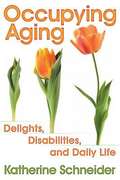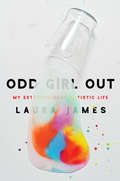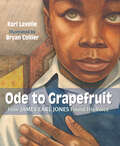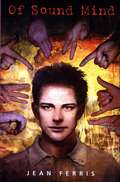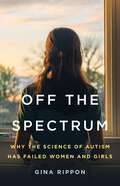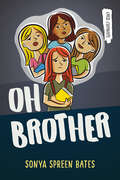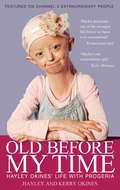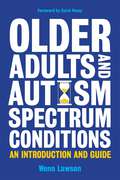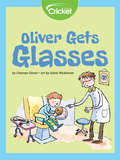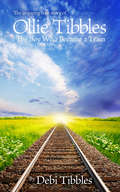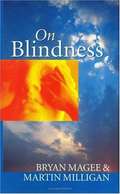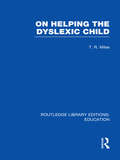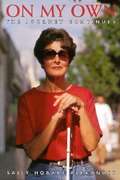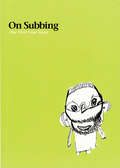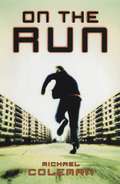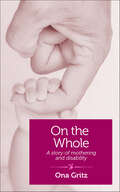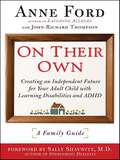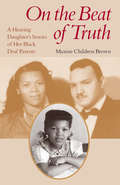- Table View
- List View
Occupying Aging
by Katherine SchneiderPerhaps you’re one of the forty million Americans over sixty-five or the 76 million Americans called baby boomers who are joining the over sixty-five set at a rate of 8,000 per day. I’m one of you and would love to take you on a ride with me through a full year of occupying aging. I’ve been blind since birth and have had fibromyalgia for over twenty years, so I’ve struggled with disabilities and society’s disabling attitudes long enough to have learned a few tricks of the trade. As you’ll see if you tag along, sometimes they work and sometimes…I’m not sure who first said “if it doesn’t kill you, it’ll make you stronger” but I could have that as my motto. The year is full of delightful people and events, as well as tears and laughter. The other major characters in this journal are my Seeing Eye dogs past and present. They’d encourage you to read the book because then at least some good will come of my spending so much time tapping on the keyboard of my talking computer. Welcome to my year of occupying aging. I hope it encourages you in occupying your life at whatever stage in the journey of life you are.
Ochún y yo: Oshún and Me: A Story of Love and Braids
by Adiba NelsonAudiolibro debut de Adiba Nelson, Ochún y Yo, es una conmovedora oda a la familia, la identidad y la belleza de las trenzas. ¡También disponible en inglés!¡Es domingo y eso significa que es el día de hacerte el pelo! Mientras Mami teje oro y conchas de cauri en el cabello de Yadira, le cuenta la historia de la diosa Ochún, mostrándole a Yadi cómo su herencia afro latina está amorosamente tejida en cada trenza y concha.Al día siguiente, Yadi llega a su primer día en una nueva escuela. Está nerviosa por hacer amigos, pero con sus hermosas trenzas, el clic-clac de las conchas de cauri y un poco de guía de Ochún, ella descubre que tiene todo lo que necesita para ser su mejor y más auténtica versión de sí misma. Al final del libro se incluye una carta del autor e información sobre diferentes tipos de peinados trenzados.
Odd Girl Out: My Extraordinary Autistic Life
by Laura James<P>A sensory portrait of an autistic mind <P>From childhood, Laura James knew she was different. She struggled to cope in a world that often made no sense to her, as though her brain had its own operating system. <P>It wasn't until she reached her forties that she found out why: Suddenly and surprisingly, she was diagnosed with autism. With a touching and searing honesty, Laura challenges everything we think we know about what it means to be autistic. <P>Married with four children and a successful journalist, Laura examines the ways in which autism has shaped her career, her approach to motherhood, and her closest relationships. <P>Laura's upbeat, witty writing offers new insight into the day-to-day struggles of living with autism, as her extreme attention to sensory detail--a common aspect of her autism--is fascinating to observe through her eyes. <P>As Laura grapples with defining her own identity, she also looks at the unique benefits neurodiversity can bring. <P>Lyrical and lush, Odd Girl Out shows how being different doesn't mean being less, and proves that it is never too late for any of us to find our rightful place in the world.
Ode to Grapefruit: How James Earl Jones Found His Voice
by Kari LavelleBefore legendary actor James Earl Jones was recognized for his memorable, smooth voice, he was just James--a stutterer who stopped speaking for eight years as a child...and ultimately found his voice through poetry.Before there was Mufasa...Before there was Darth Vader... There was a young boy names James Earl Jones, who spoke with a stutter and dreaded having to talk in class. Whenever James tried to voice his thoughts, his words got stuck in his throat. But James figured out a solution for his shame: if he didn't speak, he wouldn't stutter. And so he was silent...until he wrote his own poem, Ode to Grapefruit, and found a love for poetry. Lyrical text, stunning art, and compelling backmatter about stuttering pair together for a remarkable picture book about how a boy who refused to speak for eight years learned to manage his stutter through poetry--and grew up to become an EGOT-winning performer with a voice few could forget.
Odor of Violets (Duncan Maclain Mystery #3)
by Baynard KendrickA paragraph in a gossip column causes two violent deaths... and all sorts of odd clues lead Captain Duncan Maclain, the brilliant private detective who is totally blind, on his next a strange and spectacular case. The third mystery in the series that inspired the popular television show "Longstreet."
Of Beatles and Angels: a Boy's Remarkable Journey from a Refugee Camp to harvard
by Mawi Asgedom Dave BergerMawi Asgedom moved from a Sudanese refugee camp to Chicago when he was three years old. His father, formerly a doctor in Ethiopia had to do back-breaking work in order to support his family, but he always encouraged the author to dream and to educate himself. After years of struggle, he was accepted with a scholarship to Harvard University. Includes recipes. An excellent biography for young readers.
Of Sound Mind
by Jean FerrisTired of interpreting for his deaf family and resentful of their reliance on him, high school senior Theo finds support and understanding from Ivy, a new student who also has a deaf parent.
Of Such Small Differences
by Joanne GreenbergIn this poetic novel, 25-year-old John Moon, who is deaf-blind, has a job in a sheltered workshop and lives within a small community of friends who are deaf or deaf-blind. Life for John is transformed when he falls in love with Leda, a young actress working as a driver for the workshop. As their relationship develops John learns about his own capacity for joy and suffering, and struggles to find his place in the world of people who hear and se. The novel is written from John's point of view and attempts to convey his perceptions as a deaf-blind person.
Off the Grid
by Robert W. KingettJournalist Robert Kingett accepts a dare: one that at first seems simple... to adapt to his blindness without the Internet. This account is a cozy diary of battling with an FM radio, hooking up a landline phone and the journey of adapting to a brand new way of living from someone who has never disconnected from the World Wide Web.
Off the Spectrum: Why the Science of Autism Has Failed Women and Girls
by Gina RipponA cognitive neuroscientist reveals how autistic women have been overlooked by biased research—and makes a passionate case for their inclusion Who comes to mind when you think about an autistic person? It might be yourself, a relative or friend, a public figure, a fictional character, or a stereotyped image. Regardless, for most of us, it&’s likely to be someone male. Autistic women are systematically underdiagnosed, under-researched, and underserved by medical and social systems—to devastating effects. In Off the Spectrum, cognitive neuroscientist Gina Rippon sheds light on how old ideas about autism leave women behind and how the scientific community must catch up. Generations of researchers, convinced autism was a male problem, simply didn&’t bother looking for it in women, creating a snowball effect of biased research. To correct this &“male spotlight&” problem, Rippon outlines how autism presents differently in girls and women—like their tendency to camouflage their autistic traits, or how their intense interests may take a form considered to be more socially acceptable. When autism research studies don&’t recruit female participants, Rippon argues, it&’s not only autistic women who are failed; it&’s the entire scientific community. Correcting a major scientific bias, Off the Spectrum provides a much-needed exploration of autism in women to parents, clinicians, and autistic women themselves.
Oh Brother (Orca Currents)
by Sonya Spreen BatesMoving to a new city and a new school is never easy. So Lauren is relieved when Callie, Treena and Maddy welcome her into their group. But then Lauren witnesses their reaction to a first-grader in a wheelchair. That kid is her little brother, Will. But she’s afraid that if she tells them, they may not want to be friends with her. Soon Lauren finds herself living a double life as she struggles with the challenges of building new friendships and trying to make it up to Will for not acknowledging him at school. At some point Lauren will have to make a decision. What is more important—friends or family? The epub edition of this title is fully accessible.
Old Before My Time
by Hayley OkinesHayley's an extraordinary girl -- Kylie Minogue Hayley just lights up a room. She's so full of happiness -- Lorraine Kelly Hayley Okines is like no other 13-year-old schoolgirl.In Old Before My Time, Hayley and her mum Kerry reflect on her unusual life. Share Hayley's excitement as she travels the world meeting her pop heroes Kylie, Girls Aloud and Justin Bieber and her sadness as she loses her best friend to the disease at the age of 11. Now as she passes the age of 13 - the average life expectancy for a child with progeria - Hayley talks frankly about her hopes for the future and her pioneering drug trials in America which could unlock the secrets of ageing for everyone...
Old Dogs and New Tricks
by Kenneth JerniganThe tenth book in the Kernel Book Series contains these vignettes: Editor's Introduction Old Dogs and New Tricks The Sliding Board Tending to My Knitting Roller Coasters Serving Communion and Loving Elizabeth. Other books in this series are available from Bookshare.
Older Adults and Autism Spectrum Conditions: An Introduction and Guide
by Carol Povey Wenn B. LawsonThe first book to look seriously at the practical issues facing older adults with autism spectrum conditions (ASC), Wenn Lawson's groundbreaking handbook offers support, advice, and sensible ways in which to look at the issues. Informed by current research, interviews with older people diagnosed with ASC and his own experience, the author covers a multitude of issues including dealing with transitions and changes to routine, communicating an individual's particular needs and wishes to care home staff, the social and financial impact of retirement, mental health, and sensory and physical changes and challenges. Older people with ASC and their family and friends, as well as the professionals supporting them, will find this an indispensable and accessible book.
Oliver Gets Glasses
by Charnan SimonWhen Oliver cannot see the difference between cows and horses, his mom takes him to the eye doctor for the first time! Oliver learns about the eye and how it allows him to see. Dr. Walker then shows him how he is able to tell if the eye is healthy! Will Oliver need to get glasses?
Ollie Tibbles
by Debi TibblesWhen 4-year-old Ollie Tibbles was asked what he wanted to be when he grew up, he answered, "I'm going to be a train!" Four years later at Union Station-Chicago, at Make-A-Wish Foundation's Grand Ball, Ollie's prediction and wish came true. Ollie's mother shares the story of his struggle with brain cancer and how pain was transformed into possibility.
On Blindness: Letters Between Bryan Magee and Martin Milligan
by Bryan Magee Martin MilliganOn Blindness asks fascinating questions about the world of the blind, including: How can the born-blind know they are blind? Can a blind person play a game of snooker? How does a blind person dream? On Blindness open the eyes of the sighted to the world as experienced by the blind, offering a unique opportunity to explore the challenges, frustrations,joys--and extraordinary insights--experienced in discovering the world without sight. What difference does sight--or its absence--make to our ideas about the world? What begins as a philosophical exchange between the noted philosopher and broadcaster Bryan Magee and the late Martin Milligan, activist and philosopher--blind almost from birth-- develops into an intense and personal discussion of the implications of blindness. The debate is vigorous and often heated; sometimes contentious, it is always stimulating. They discuss the whole spectrum of blind-experience, including the born-blind, those who lose their sight, and those forced to come to terms with the shock of gaining a sight they had never possessed. This extraordinary book casts new light on one of the most fundamental aspects of human experience. It will make fascinating reading for anyone interested insight and blindness from a personal, practical, or philosophical point of view.
On Different Roads: An Autobiography
by Geraldine LawhornA true story of an incredible woman who was not about to be held back by the challenges of becoming blind and deaf before she completed high school. Not only does Geraldine Lawhorn live a full life, but she also continues to help others.
On Helping the Dyslexic Child (Routledge Library Editions: Education)
by T R MilesMany dyslexic children are well above the average in intelligence yet their disability makes progress at school extra hard and reading is often such an effort that they are deprived of the enjoyment from books. The author describes the difficulties of these children and records some of his own experiences in trying to help them. He emphasises the relief to children and parents when at last difficulties are being understood and taken seriously. Although much has changed in our understanding of dyslexia since this book was published, it remains an important historical record of the early recognition and treatment of the condition which formed an important spring-board for subsequent progress in our understanding of dyslexia.
On My Own: The Journey Continues
by Sally Hobart AlexanderThe second part of the author's autobiography, of which the first part, Taking Hold, was published in 1994. The author describes the difficulties and accomplishments she experiences as she adjusts to living independently after losing her sight.
On Subbing: The First Four Years (World Around Us (World Around Us Ser.)
by Dave RocheOn Subbing is a quiet classic. It's impossible to put down, or forget, Dave Roche's vivid, self-deprecating, tales of woe from working as a substitute teaching assistant in Portland's elementary schools in the early 2000s. <P><P>He writes about the good days and the terrible ones, helping kids who can't function in normal classrooms focus on their work, keeping kids from fighting, and keeping his composure while they tease him or adorably flirt with him. It's a real heartwarming ticket to putting a smile on your face and turning your day around.
On The Run
by Michael ColemanFifteen-year-old Luke is a skilled thief with a perfect record until the day he is caught running from a robbery gone wrong. He chooses to save the life of a blind girl, Jodi, rather than escape cleanly. As a result, Luke is given a shot at freedom if he will train to be Jodi's guide in the London Marathon. The friendship that develops between the two offers Luke one last chance to discover just how far-and in what direction-he is willing to run. A taut, unpredictable read, this novel will appeal to anyone who has changed course in life . . . or is trying to figure out how.
On The Whole: A Story of Mothering and Disability
by Ona GritzOna Gritz has had cerebral palsy all her life, but until she gave birth to her son, she didn’t really understand what it meant to be disabled. Her cerebral palsy affects her coordination and balance but not enough to have ever truly hindered her. “For the most part, I considered my disability a cosmetic issue,” she tells us in On the Whole. “Just how obvious is it? Do people see me as pretty despite the limp?” But now she’s got a new baby to care for, and no one has warned her what a physical job she has taken on. She can’t bathe her son by herself or carry him up or down a flight of stairs. Nor can she feed herself or even open a refrigerator with a baby in her arms. And her baby will settle for nothing less than being in her arms. With lyricism and candor, poet Ona Gritz shares her son’s first years with us, a time when she wanted nothing more than what all of us want—to be the perfect mother, only her imperfections kept getting in the way.
On Their Own: Creating an Independent Future for Your Adult Child with Learning Disabilities and ADHD
by Anne Ford John-Richard ThompsonAn indispensable guide to the special challenges faced by parents of learning-disabled children as they enter adulthood, by the author of Laughing Allegra, a leading activist and parent of an adult child with LD.In 2003 Anne Ford (great-granddaughter of Henry Ford) published Laughing Allegra, about the struggles of raising her learning-disabled daughter, and received a flood of letters from parents of children with LD, ADD, and ADHD, many expressing concerns about what to do as their children age.On Their Own is an invaluable road map to ease these parents' fears and answer their questions, especially the one that haunts them daily: Will or can their child be on their own, and how? In a candid, sympathetic style, laced with real-life stories, the book covers such topics as:Social skills and datingStaying healthySibling relationshipsInteraction with employers and co-workersJob huntingFinding the right college or trade schoolEstate planningAlso included are a comprehensive resource guide and exclusive interviews with prominent professionals who have surmounted their learning disabilities: CEO's Sir Richard Branson, John Chambers, David Neeleman, and Charles Schwab, and former governor Gaston Caperton.
On the Beat of Truth: A Hearing Daughter’s Stories of Her Black Deaf Parents
by Maxine Childress BrownAs an African American woman born in 1943, Maxine Childress Brown possessed a unique vantage point to witness the transformative events in her parents' lives. Both came from the South -- her father, Herbert Childress, from Nashville, TN, and her mother, Thomasina Brown, from Concord, NC. The oldest of three daughters, Maxine was fascinated by her parents' stories. She marveled at how they raised a well-respected, middle-class family in the midst of segregation with the added challenge of being deaf. Her parents met in Washington, DC, where they married and settled down. Her father worked as a shoe repairman for $65 per week for more than 15 years. A gifted seamstress, her mother gave up sewing to clean houses. Because of their modest means, Maxine and her sisters lived more than modest lives. When Maxine's tonsils became infected, her parents could not afford the operation to have them removed. For her high school prom, her mother bought her a dress on credit because she had no time to sew. Herbert Childress showed great love for his young daughters, but events turned him to bitterness and to drink. Throughout all, Thomasina encouraged her girls, always urging them to excel. She demanded their honest best with her signature phrase, her flat hand raised from her mouth straight up in the air, "on the beat of truth."
